Detailed Homicide Report: Murder, Manslaughter, and Sentencing in UK
VerifiedAdded on 2020/10/22
|11
|3131
|325
Report
AI Summary
This report provides a detailed analysis of homicide, differentiating between murder and manslaughter within the UK legal framework. It explores various classes of manslaughter, including voluntary, involuntary, constructive, and gross negligence manslaughter, outlining their key distinctions and legal implications. The report further examines the defenses of provocation and suicide pacts in murder and manslaughter cases, detailing the conditions under which these defenses may be applicable. Additionally, it covers the main principles and procedures for sentencing in both murder and manslaughter cases, considering factors such as culpability, harm, and the influence of the verdict on victims. The report highlights sentencing guidelines, statutory principles, and the role of the Sentencing Council in ensuring consistency and fairness in the criminal justice system. The document concludes by summarizing the key elements and principles that contribute to the occurrence of an offense and the corresponding legal procedures.

X Homicide
Paraphrase This Document
Need a fresh take? Get an instant paraphrase of this document with our AI Paraphraser
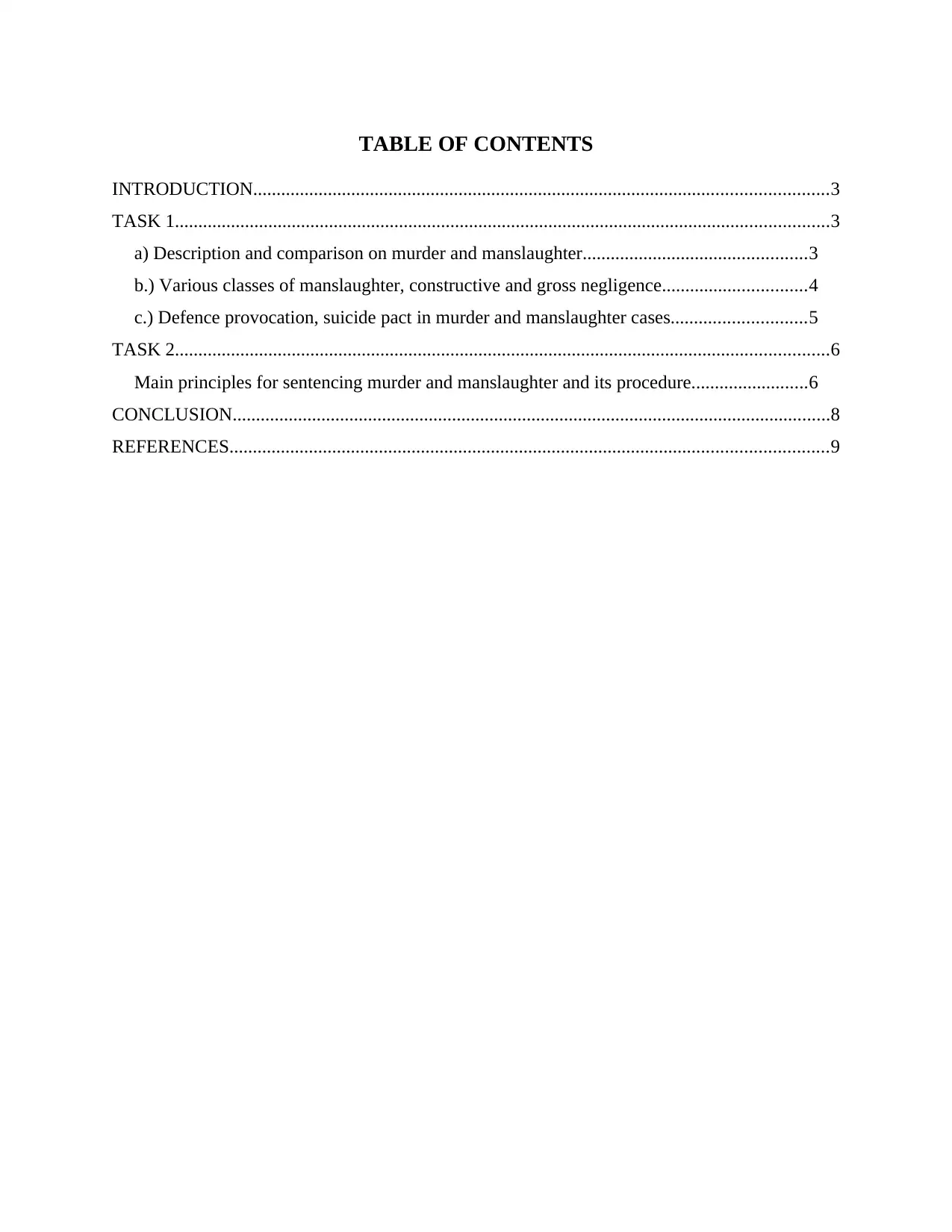
TABLE OF CONTENTS
INTRODUCTION...........................................................................................................................3
TASK 1............................................................................................................................................3
a) Description and comparison on murder and manslaughter................................................3
b.) Various classes of manslaughter, constructive and gross negligence...............................4
c.) Defence provocation, suicide pact in murder and manslaughter cases.............................5
TASK 2............................................................................................................................................6
Main principles for sentencing murder and manslaughter and its procedure.........................6
CONCLUSION................................................................................................................................8
REFERENCES................................................................................................................................9
INTRODUCTION...........................................................................................................................3
TASK 1............................................................................................................................................3
a) Description and comparison on murder and manslaughter................................................3
b.) Various classes of manslaughter, constructive and gross negligence...............................4
c.) Defence provocation, suicide pact in murder and manslaughter cases.............................5
TASK 2............................................................................................................................................6
Main principles for sentencing murder and manslaughter and its procedure.........................6
CONCLUSION................................................................................................................................8
REFERENCES................................................................................................................................9
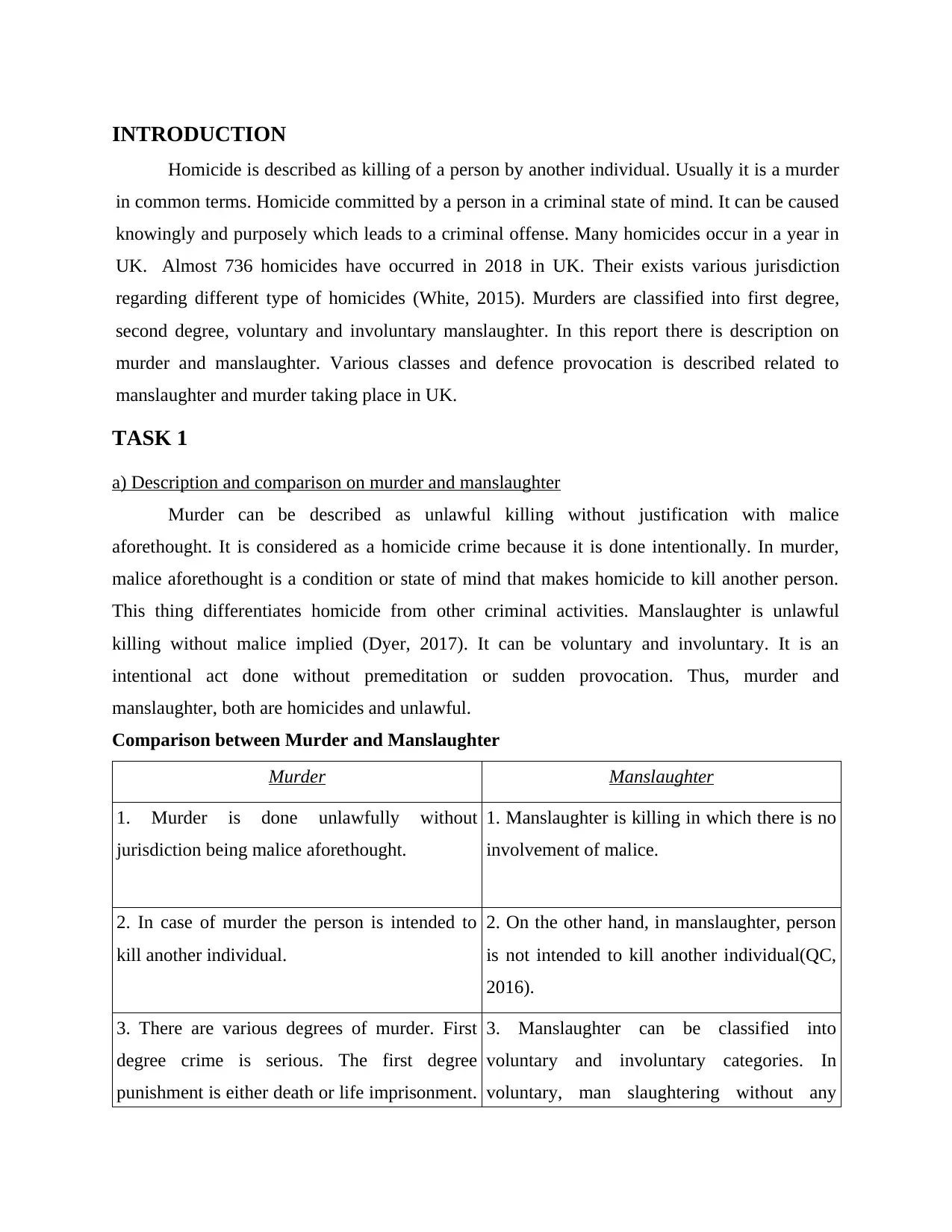
INTRODUCTION
Homicide is described as killing of a person by another individual. Usually it is a murder
in common terms. Homicide committed by a person in a criminal state of mind. It can be caused
knowingly and purposely which leads to a criminal offense. Many homicides occur in a year in
UK. Almost 736 homicides have occurred in 2018 in UK. Their exists various jurisdiction
regarding different type of homicides (White, 2015). Murders are classified into first degree,
second degree, voluntary and involuntary manslaughter. In this report there is description on
murder and manslaughter. Various classes and defence provocation is described related to
manslaughter and murder taking place in UK.
TASK 1
a) Description and comparison on murder and manslaughter
Murder can be described as unlawful killing without justification with malice
aforethought. It is considered as a homicide crime because it is done intentionally. In murder,
malice aforethought is a condition or state of mind that makes homicide to kill another person.
This thing differentiates homicide from other criminal activities. Manslaughter is unlawful
killing without malice implied (Dyer, 2017). It can be voluntary and involuntary. It is an
intentional act done without premeditation or sudden provocation. Thus, murder and
manslaughter, both are homicides and unlawful.
Comparison between Murder and Manslaughter
Murder Manslaughter
1. Murder is done unlawfully without
jurisdiction being malice aforethought.
1. Manslaughter is killing in which there is no
involvement of malice.
2. In case of murder the person is intended to
kill another individual.
2. On the other hand, in manslaughter, person
is not intended to kill another individual(QC,
2016).
3. There are various degrees of murder. First
degree crime is serious. The first degree
punishment is either death or life imprisonment.
3. Manslaughter can be classified into
voluntary and involuntary categories. In
voluntary, man slaughtering without any
Homicide is described as killing of a person by another individual. Usually it is a murder
in common terms. Homicide committed by a person in a criminal state of mind. It can be caused
knowingly and purposely which leads to a criminal offense. Many homicides occur in a year in
UK. Almost 736 homicides have occurred in 2018 in UK. Their exists various jurisdiction
regarding different type of homicides (White, 2015). Murders are classified into first degree,
second degree, voluntary and involuntary manslaughter. In this report there is description on
murder and manslaughter. Various classes and defence provocation is described related to
manslaughter and murder taking place in UK.
TASK 1
a) Description and comparison on murder and manslaughter
Murder can be described as unlawful killing without justification with malice
aforethought. It is considered as a homicide crime because it is done intentionally. In murder,
malice aforethought is a condition or state of mind that makes homicide to kill another person.
This thing differentiates homicide from other criminal activities. Manslaughter is unlawful
killing without malice implied (Dyer, 2017). It can be voluntary and involuntary. It is an
intentional act done without premeditation or sudden provocation. Thus, murder and
manslaughter, both are homicides and unlawful.
Comparison between Murder and Manslaughter
Murder Manslaughter
1. Murder is done unlawfully without
jurisdiction being malice aforethought.
1. Manslaughter is killing in which there is no
involvement of malice.
2. In case of murder the person is intended to
kill another individual.
2. On the other hand, in manslaughter, person
is not intended to kill another individual(QC,
2016).
3. There are various degrees of murder. First
degree crime is serious. The first degree
punishment is either death or life imprisonment.
3. Manslaughter can be classified into
voluntary and involuntary categories. In
voluntary, man slaughtering without any
⊘ This is a preview!⊘
Do you want full access?
Subscribe today to unlock all pages.

Trusted by 1+ million students worldwide

In second degree, criminal homicide offense is
done and is known as Felony Murder rule. This
degree is punishable (Gurian, Elizabeth A,
2018). In third degree, a person shoots another
one and punishment is between 10 and 20
years. For example, In England Ann Maguire
was stabbed to death while teaching a Spanish
lesson in Leeds. The perpetrator William
committed the murder when he was 15 years of
age and was jailed for minimum 20 years at
Leeds Crown Court on 3rd November 2014.
lawful base, killing is done on intentional
basis, from getting provoked by another
person who was killed. On the other hand,
when a person is dead due to unlawful act and
recklessness, it is known as involuntary
manslaughter (Stewart and et.al, 2018). For
example, D stabbed his pregnant girlfriend in
the abdomen. She gave birth to premature
child and the baby died after months.
Intentionally, D committed an unlawful and
dangerous act that resulted in the death of a
human being.
b.) Various classes of manslaughter, constructive and gross negligence
Manslaughter is a criminal offence in which there is no involvement of malice
aforethought. It can be categorised into two classes:
Voluntary Manslaughter: Voluntary manslaughter is an act in which there is killing of a person
that is considered as murder because it is committed due to adequate provocation. Criminal
charges are minimized in voluntary manslaughter if adequate provocation resulted in the killing
of a person. Adequate provocation can be described as something that is enough to incite a
normal person to become an intense and sudden person. Court accept following types of
provocation:
1. The defendant is never calm down.(Miller, 2015).
2. There is actually provocation done in order to aggrevate the defendant.
3. Act or conduct adequately in order to deprive a reasonable person for self-control.
4. There is not enough time between provocation and actual killing and the person never
calm down.
For example: Rv Ibrams and Gregory (1981) 74 Cr App R 154. A young woman and defendants
were bullied and terrorised by the deceased over a certain period of time on 7 October. On 10
October they made a plan that included the man enticing the woman to her bed and defendants
burst into the room and attacked him (Griffith, 2018). The defendants made an appeal to judge
done and is known as Felony Murder rule. This
degree is punishable (Gurian, Elizabeth A,
2018). In third degree, a person shoots another
one and punishment is between 10 and 20
years. For example, In England Ann Maguire
was stabbed to death while teaching a Spanish
lesson in Leeds. The perpetrator William
committed the murder when he was 15 years of
age and was jailed for minimum 20 years at
Leeds Crown Court on 3rd November 2014.
lawful base, killing is done on intentional
basis, from getting provoked by another
person who was killed. On the other hand,
when a person is dead due to unlawful act and
recklessness, it is known as involuntary
manslaughter (Stewart and et.al, 2018). For
example, D stabbed his pregnant girlfriend in
the abdomen. She gave birth to premature
child and the baby died after months.
Intentionally, D committed an unlawful and
dangerous act that resulted in the death of a
human being.
b.) Various classes of manslaughter, constructive and gross negligence
Manslaughter is a criminal offence in which there is no involvement of malice
aforethought. It can be categorised into two classes:
Voluntary Manslaughter: Voluntary manslaughter is an act in which there is killing of a person
that is considered as murder because it is committed due to adequate provocation. Criminal
charges are minimized in voluntary manslaughter if adequate provocation resulted in the killing
of a person. Adequate provocation can be described as something that is enough to incite a
normal person to become an intense and sudden person. Court accept following types of
provocation:
1. The defendant is never calm down.(Miller, 2015).
2. There is actually provocation done in order to aggrevate the defendant.
3. Act or conduct adequately in order to deprive a reasonable person for self-control.
4. There is not enough time between provocation and actual killing and the person never
calm down.
For example: Rv Ibrams and Gregory (1981) 74 Cr App R 154. A young woman and defendants
were bullied and terrorised by the deceased over a certain period of time on 7 October. On 10
October they made a plan that included the man enticing the woman to her bed and defendants
burst into the room and attacked him (Griffith, 2018). The defendants made an appeal to judge
Paraphrase This Document
Need a fresh take? Get an instant paraphrase of this document with our AI Paraphraser

that time gap between the last act of provocation and the killing refuted evidence that resulted
suffering due to loss of self-control.
Involuntary manslaughter: Involuntary manslaughter is unintentional killing of another person
due to lack of care. For example: Rv Franklin (1883) 15 Cox CC 163, while walking along a
pier, the defendant threw a big sized box over the sea, which struck a swimmer and killed him.
He found himself guilty of manslaughter as death arose from unlawful act because it taking
another's belongings and throwing into the sea (Mishara and Weisstub, 2016).
Constructive Manslaughter: It is an unlawful act, in which, malicious intent of offense is
implemented or applied onto the consequences of that misconduct (Golden, 2018). It focuses on
the principles of responsibility, minimal criminalisation, proportionality, fair labelling and
correspondence. It has three elements:
1. The act must be dangerous.
2. The crime must be done unlawfully (Sng, 2016).
3. Act must resulted in the death of victim.
Gross Negligence
Gross negligence manslaughter is a form of involuntary assassination in which, the
defendant has tried to act ostensibly lawful. In this, he/she lacks 'mens rea' of murder because the
defendant is neither intended to cause death or seriously harming body by another person. It is
mostly due to lack of slight care or diligence and is suspected by the English Law (Selby and
et.al., 2017). In UK, the Prosecutor has to prove the existence of duty of care or breach of duty
that has led to death.
c.) Defence provocation, suicide pact in murder and manslaughter cases
Defence of provocation is further described as a special defence which is included in
Homicide Act 1957 along with suicide pact and diminished responsibility. They are only
implemented to law of murder. Defence of Provocation can be found in Homicide Act 1957.
Basic requirements of this act are as follows:
1. The defendant must have been provoked to lose their self-control.
2. There must be an evidence for the act of provocation.
For example, according to Homicide Act 1957 and in the case of Rv Ibrams and Gregory (1981)
74 Cr App R 154 2004, Law commission recommended some reviews and defence of
suffering due to loss of self-control.
Involuntary manslaughter: Involuntary manslaughter is unintentional killing of another person
due to lack of care. For example: Rv Franklin (1883) 15 Cox CC 163, while walking along a
pier, the defendant threw a big sized box over the sea, which struck a swimmer and killed him.
He found himself guilty of manslaughter as death arose from unlawful act because it taking
another's belongings and throwing into the sea (Mishara and Weisstub, 2016).
Constructive Manslaughter: It is an unlawful act, in which, malicious intent of offense is
implemented or applied onto the consequences of that misconduct (Golden, 2018). It focuses on
the principles of responsibility, minimal criminalisation, proportionality, fair labelling and
correspondence. It has three elements:
1. The act must be dangerous.
2. The crime must be done unlawfully (Sng, 2016).
3. Act must resulted in the death of victim.
Gross Negligence
Gross negligence manslaughter is a form of involuntary assassination in which, the
defendant has tried to act ostensibly lawful. In this, he/she lacks 'mens rea' of murder because the
defendant is neither intended to cause death or seriously harming body by another person. It is
mostly due to lack of slight care or diligence and is suspected by the English Law (Selby and
et.al., 2017). In UK, the Prosecutor has to prove the existence of duty of care or breach of duty
that has led to death.
c.) Defence provocation, suicide pact in murder and manslaughter cases
Defence of provocation is further described as a special defence which is included in
Homicide Act 1957 along with suicide pact and diminished responsibility. They are only
implemented to law of murder. Defence of Provocation can be found in Homicide Act 1957.
Basic requirements of this act are as follows:
1. The defendant must have been provoked to lose their self-control.
2. There must be an evidence for the act of provocation.
For example, according to Homicide Act 1957 and in the case of Rv Ibrams and Gregory (1981)
74 Cr App R 154 2004, Law commission recommended some reviews and defence of
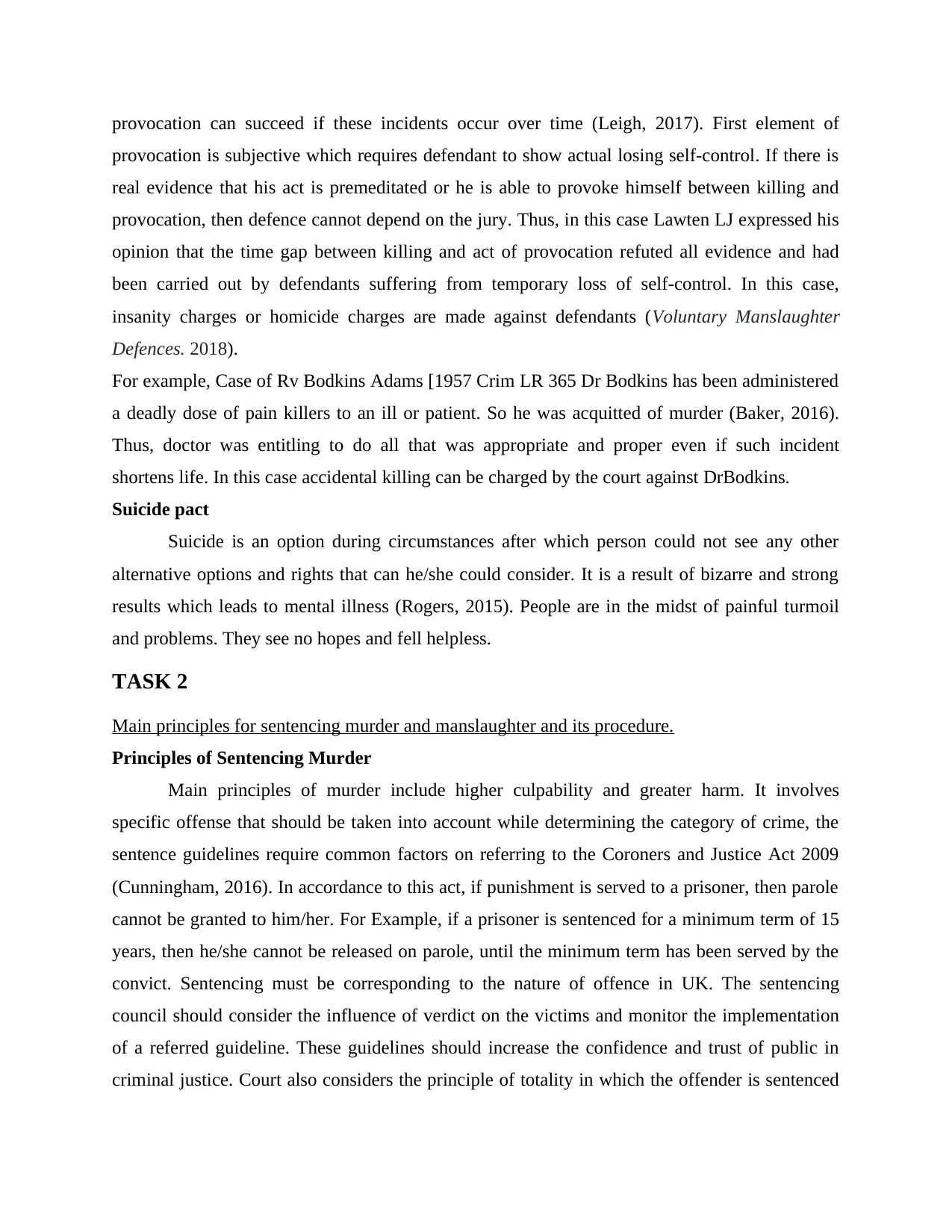
provocation can succeed if these incidents occur over time (Leigh, 2017). First element of
provocation is subjective which requires defendant to show actual losing self-control. If there is
real evidence that his act is premeditated or he is able to provoke himself between killing and
provocation, then defence cannot depend on the jury. Thus, in this case Lawten LJ expressed his
opinion that the time gap between killing and act of provocation refuted all evidence and had
been carried out by defendants suffering from temporary loss of self-control. In this case,
insanity charges or homicide charges are made against defendants (Voluntary Manslaughter
Defences. 2018).
For example, Case of Rv Bodkins Adams [1957 Crim LR 365 Dr Bodkins has been administered
a deadly dose of pain killers to an ill or patient. So he was acquitted of murder (Baker, 2016).
Thus, doctor was entitling to do all that was appropriate and proper even if such incident
shortens life. In this case accidental killing can be charged by the court against DrBodkins.
Suicide pact
Suicide is an option during circumstances after which person could not see any other
alternative options and rights that can he/she could consider. It is a result of bizarre and strong
results which leads to mental illness (Rogers, 2015). People are in the midst of painful turmoil
and problems. They see no hopes and fell helpless.
TASK 2
Main principles for sentencing murder and manslaughter and its procedure.
Principles of Sentencing Murder
Main principles of murder include higher culpability and greater harm. It involves
specific offense that should be taken into account while determining the category of crime, the
sentence guidelines require common factors on referring to the Coroners and Justice Act 2009
(Cunningham, 2016). In accordance to this act, if punishment is served to a prisoner, then parole
cannot be granted to him/her. For Example, if a prisoner is sentenced for a minimum term of 15
years, then he/she cannot be released on parole, until the minimum term has been served by the
convict. Sentencing must be corresponding to the nature of offence in UK. The sentencing
council should consider the influence of verdict on the victims and monitor the implementation
of a referred guideline. These guidelines should increase the confidence and trust of public in
criminal justice. Court also considers the principle of totality in which the offender is sentenced
provocation is subjective which requires defendant to show actual losing self-control. If there is
real evidence that his act is premeditated or he is able to provoke himself between killing and
provocation, then defence cannot depend on the jury. Thus, in this case Lawten LJ expressed his
opinion that the time gap between killing and act of provocation refuted all evidence and had
been carried out by defendants suffering from temporary loss of self-control. In this case,
insanity charges or homicide charges are made against defendants (Voluntary Manslaughter
Defences. 2018).
For example, Case of Rv Bodkins Adams [1957 Crim LR 365 Dr Bodkins has been administered
a deadly dose of pain killers to an ill or patient. So he was acquitted of murder (Baker, 2016).
Thus, doctor was entitling to do all that was appropriate and proper even if such incident
shortens life. In this case accidental killing can be charged by the court against DrBodkins.
Suicide pact
Suicide is an option during circumstances after which person could not see any other
alternative options and rights that can he/she could consider. It is a result of bizarre and strong
results which leads to mental illness (Rogers, 2015). People are in the midst of painful turmoil
and problems. They see no hopes and fell helpless.
TASK 2
Main principles for sentencing murder and manslaughter and its procedure.
Principles of Sentencing Murder
Main principles of murder include higher culpability and greater harm. It involves
specific offense that should be taken into account while determining the category of crime, the
sentence guidelines require common factors on referring to the Coroners and Justice Act 2009
(Cunningham, 2016). In accordance to this act, if punishment is served to a prisoner, then parole
cannot be granted to him/her. For Example, if a prisoner is sentenced for a minimum term of 15
years, then he/she cannot be released on parole, until the minimum term has been served by the
convict. Sentencing must be corresponding to the nature of offence in UK. The sentencing
council should consider the influence of verdict on the victims and monitor the implementation
of a referred guideline. These guidelines should increase the confidence and trust of public in
criminal justice. Court also considers the principle of totality in which the offender is sentenced
⊘ This is a preview!⊘
Do you want full access?
Subscribe today to unlock all pages.

Trusted by 1+ million students worldwide
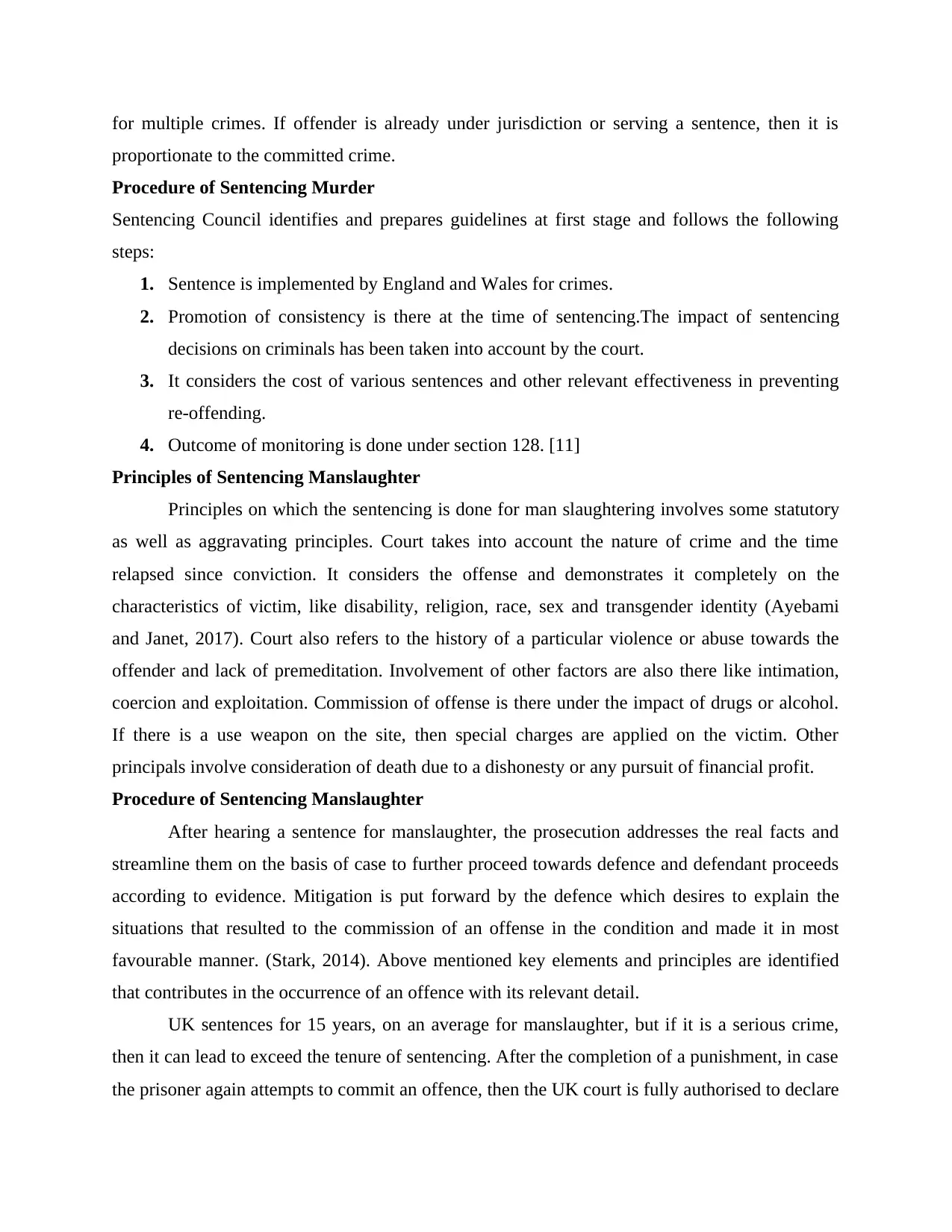
for multiple crimes. If offender is already under jurisdiction or serving a sentence, then it is
proportionate to the committed crime.
Procedure of Sentencing Murder
Sentencing Council identifies and prepares guidelines at first stage and follows the following
steps:
1. Sentence is implemented by England and Wales for crimes.
2. Promotion of consistency is there at the time of sentencing.The impact of sentencing
decisions on criminals has been taken into account by the court.
3. It considers the cost of various sentences and other relevant effectiveness in preventing
re-offending.
4. Outcome of monitoring is done under section 128. [11]
Principles of Sentencing Manslaughter
Principles on which the sentencing is done for man slaughtering involves some statutory
as well as aggravating principles. Court takes into account the nature of crime and the time
relapsed since conviction. It considers the offense and demonstrates it completely on the
characteristics of victim, like disability, religion, race, sex and transgender identity (Ayebami
and Janet, 2017). Court also refers to the history of a particular violence or abuse towards the
offender and lack of premeditation. Involvement of other factors are also there like intimation,
coercion and exploitation. Commission of offense is there under the impact of drugs or alcohol.
If there is a use weapon on the site, then special charges are applied on the victim. Other
principals involve consideration of death due to a dishonesty or any pursuit of financial profit.
Procedure of Sentencing Manslaughter
After hearing a sentence for manslaughter, the prosecution addresses the real facts and
streamline them on the basis of case to further proceed towards defence and defendant proceeds
according to evidence. Mitigation is put forward by the defence which desires to explain the
situations that resulted to the commission of an offense in the condition and made it in most
favourable manner. (Stark, 2014). Above mentioned key elements and principles are identified
that contributes in the occurrence of an offence with its relevant detail.
UK sentences for 15 years, on an average for manslaughter, but if it is a serious crime,
then it can lead to exceed the tenure of sentencing. After the completion of a punishment, in case
the prisoner again attempts to commit an offence, then the UK court is fully authorised to declare
proportionate to the committed crime.
Procedure of Sentencing Murder
Sentencing Council identifies and prepares guidelines at first stage and follows the following
steps:
1. Sentence is implemented by England and Wales for crimes.
2. Promotion of consistency is there at the time of sentencing.The impact of sentencing
decisions on criminals has been taken into account by the court.
3. It considers the cost of various sentences and other relevant effectiveness in preventing
re-offending.
4. Outcome of monitoring is done under section 128. [11]
Principles of Sentencing Manslaughter
Principles on which the sentencing is done for man slaughtering involves some statutory
as well as aggravating principles. Court takes into account the nature of crime and the time
relapsed since conviction. It considers the offense and demonstrates it completely on the
characteristics of victim, like disability, religion, race, sex and transgender identity (Ayebami
and Janet, 2017). Court also refers to the history of a particular violence or abuse towards the
offender and lack of premeditation. Involvement of other factors are also there like intimation,
coercion and exploitation. Commission of offense is there under the impact of drugs or alcohol.
If there is a use weapon on the site, then special charges are applied on the victim. Other
principals involve consideration of death due to a dishonesty or any pursuit of financial profit.
Procedure of Sentencing Manslaughter
After hearing a sentence for manslaughter, the prosecution addresses the real facts and
streamline them on the basis of case to further proceed towards defence and defendant proceeds
according to evidence. Mitigation is put forward by the defence which desires to explain the
situations that resulted to the commission of an offense in the condition and made it in most
favourable manner. (Stark, 2014). Above mentioned key elements and principles are identified
that contributes in the occurrence of an offence with its relevant detail.
UK sentences for 15 years, on an average for manslaughter, but if it is a serious crime,
then it can lead to exceed the tenure of sentencing. After the completion of a punishment, in case
the prisoner again attempts to commit an offence, then the UK court is fully authorised to declare
Paraphrase This Document
Need a fresh take? Get an instant paraphrase of this document with our AI Paraphraser
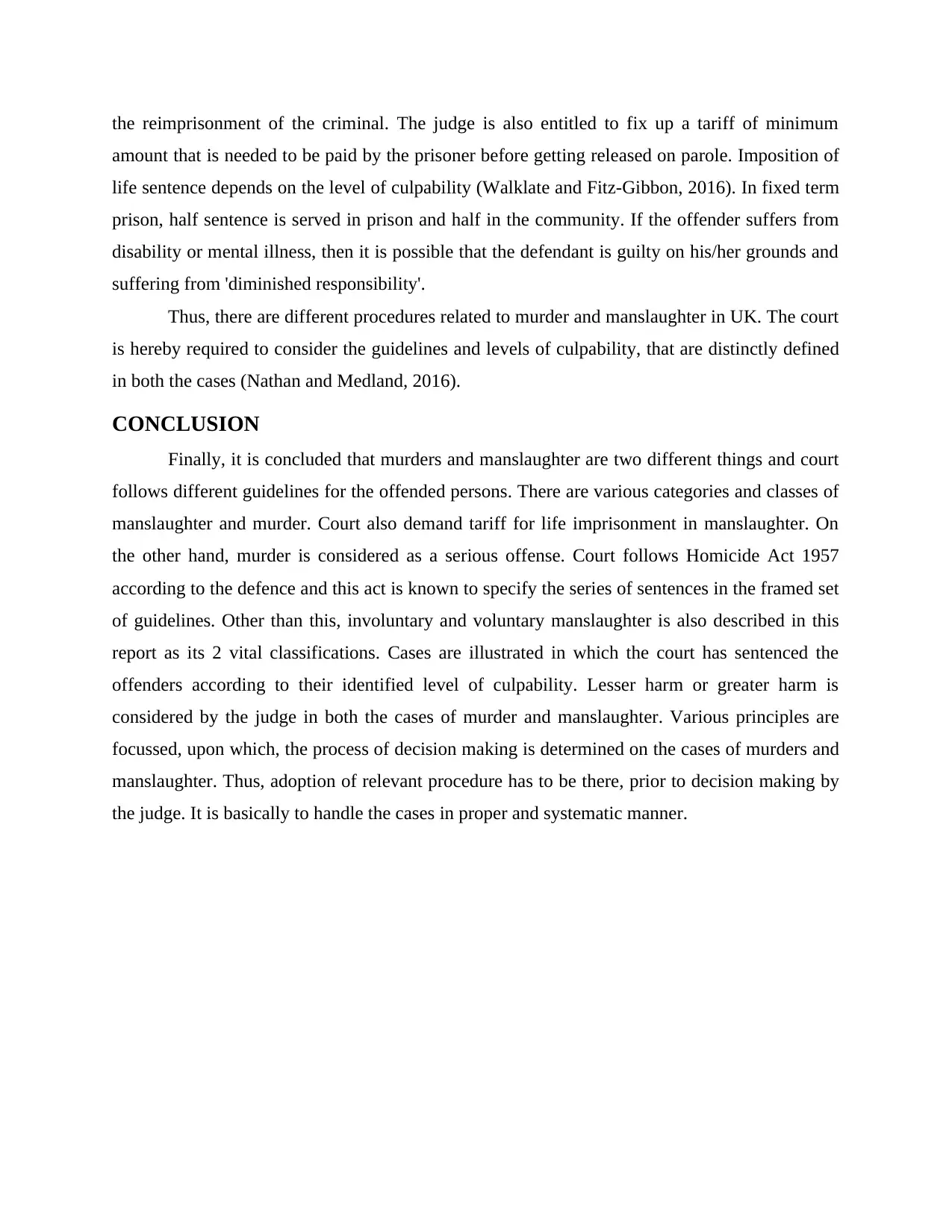
the reimprisonment of the criminal. The judge is also entitled to fix up a tariff of minimum
amount that is needed to be paid by the prisoner before getting released on parole. Imposition of
life sentence depends on the level of culpability (Walklate and Fitz-Gibbon, 2016). In fixed term
prison, half sentence is served in prison and half in the community. If the offender suffers from
disability or mental illness, then it is possible that the defendant is guilty on his/her grounds and
suffering from 'diminished responsibility'.
Thus, there are different procedures related to murder and manslaughter in UK. The court
is hereby required to consider the guidelines and levels of culpability, that are distinctly defined
in both the cases (Nathan and Medland, 2016).
CONCLUSION
Finally, it is concluded that murders and manslaughter are two different things and court
follows different guidelines for the offended persons. There are various categories and classes of
manslaughter and murder. Court also demand tariff for life imprisonment in manslaughter. On
the other hand, murder is considered as a serious offense. Court follows Homicide Act 1957
according to the defence and this act is known to specify the series of sentences in the framed set
of guidelines. Other than this, involuntary and voluntary manslaughter is also described in this
report as its 2 vital classifications. Cases are illustrated in which the court has sentenced the
offenders according to their identified level of culpability. Lesser harm or greater harm is
considered by the judge in both the cases of murder and manslaughter. Various principles are
focussed, upon which, the process of decision making is determined on the cases of murders and
manslaughter. Thus, adoption of relevant procedure has to be there, prior to decision making by
the judge. It is basically to handle the cases in proper and systematic manner.
amount that is needed to be paid by the prisoner before getting released on parole. Imposition of
life sentence depends on the level of culpability (Walklate and Fitz-Gibbon, 2016). In fixed term
prison, half sentence is served in prison and half in the community. If the offender suffers from
disability or mental illness, then it is possible that the defendant is guilty on his/her grounds and
suffering from 'diminished responsibility'.
Thus, there are different procedures related to murder and manslaughter in UK. The court
is hereby required to consider the guidelines and levels of culpability, that are distinctly defined
in both the cases (Nathan and Medland, 2016).
CONCLUSION
Finally, it is concluded that murders and manslaughter are two different things and court
follows different guidelines for the offended persons. There are various categories and classes of
manslaughter and murder. Court also demand tariff for life imprisonment in manslaughter. On
the other hand, murder is considered as a serious offense. Court follows Homicide Act 1957
according to the defence and this act is known to specify the series of sentences in the framed set
of guidelines. Other than this, involuntary and voluntary manslaughter is also described in this
report as its 2 vital classifications. Cases are illustrated in which the court has sentenced the
offenders according to their identified level of culpability. Lesser harm or greater harm is
considered by the judge in both the cases of murder and manslaughter. Various principles are
focussed, upon which, the process of decision making is determined on the cases of murders and
manslaughter. Thus, adoption of relevant procedure has to be there, prior to decision making by
the judge. It is basically to handle the cases in proper and systematic manner.
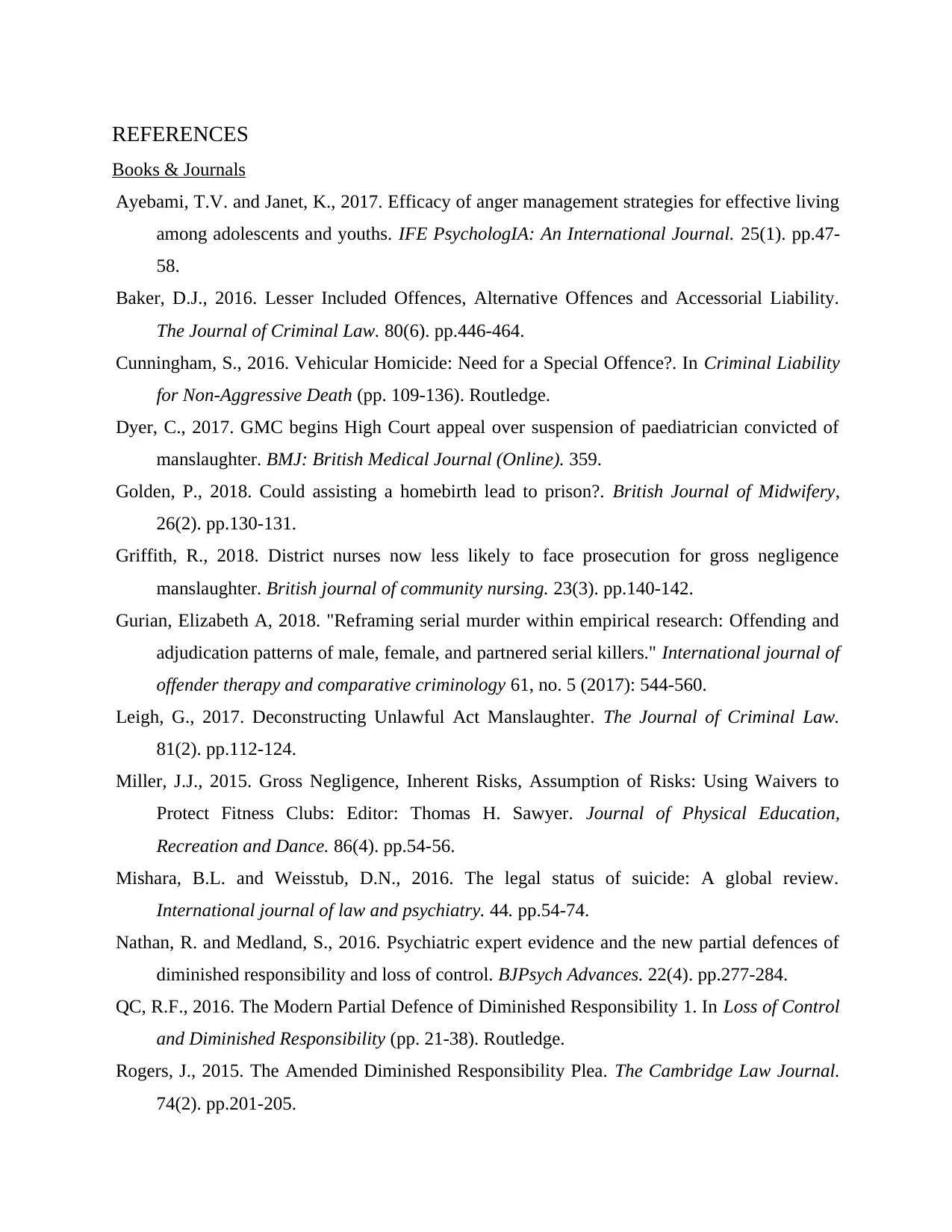
REFERENCES
Books & Journals
Ayebami, T.V. and Janet, K., 2017. Efficacy of anger management strategies for effective living
among adolescents and youths. IFE PsychologIA: An International Journal. 25(1). pp.47-
58.
Baker, D.J., 2016. Lesser Included Offences, Alternative Offences and Accessorial Liability.
The Journal of Criminal Law. 80(6). pp.446-464.
Cunningham, S., 2016. Vehicular Homicide: Need for a Special Offence?. In Criminal Liability
for Non-Aggressive Death (pp. 109-136). Routledge.
Dyer, C., 2017. GMC begins High Court appeal over suspension of paediatrician convicted of
manslaughter. BMJ: British Medical Journal (Online). 359.
Golden, P., 2018. Could assisting a homebirth lead to prison?. British Journal of Midwifery,
26(2). pp.130-131.
Griffith, R., 2018. District nurses now less likely to face prosecution for gross negligence
manslaughter. British journal of community nursing. 23(3). pp.140-142.
Gurian, Elizabeth A, 2018. "Reframing serial murder within empirical research: Offending and
adjudication patterns of male, female, and partnered serial killers." International journal of
offender therapy and comparative criminology 61, no. 5 (2017): 544-560.
Leigh, G., 2017. Deconstructing Unlawful Act Manslaughter. The Journal of Criminal Law.
81(2). pp.112-124.
Miller, J.J., 2015. Gross Negligence, Inherent Risks, Assumption of Risks: Using Waivers to
Protect Fitness Clubs: Editor: Thomas H. Sawyer. Journal of Physical Education,
Recreation and Dance. 86(4). pp.54-56.
Mishara, B.L. and Weisstub, D.N., 2016. The legal status of suicide: A global review.
International journal of law and psychiatry. 44. pp.54-74.
Nathan, R. and Medland, S., 2016. Psychiatric expert evidence and the new partial defences of
diminished responsibility and loss of control. BJPsych Advances. 22(4). pp.277-284.
QC, R.F., 2016. The Modern Partial Defence of Diminished Responsibility 1. In Loss of Control
and Diminished Responsibility (pp. 21-38). Routledge.
Rogers, J., 2015. The Amended Diminished Responsibility Plea. The Cambridge Law Journal.
74(2). pp.201-205.
Books & Journals
Ayebami, T.V. and Janet, K., 2017. Efficacy of anger management strategies for effective living
among adolescents and youths. IFE PsychologIA: An International Journal. 25(1). pp.47-
58.
Baker, D.J., 2016. Lesser Included Offences, Alternative Offences and Accessorial Liability.
The Journal of Criminal Law. 80(6). pp.446-464.
Cunningham, S., 2016. Vehicular Homicide: Need for a Special Offence?. In Criminal Liability
for Non-Aggressive Death (pp. 109-136). Routledge.
Dyer, C., 2017. GMC begins High Court appeal over suspension of paediatrician convicted of
manslaughter. BMJ: British Medical Journal (Online). 359.
Golden, P., 2018. Could assisting a homebirth lead to prison?. British Journal of Midwifery,
26(2). pp.130-131.
Griffith, R., 2018. District nurses now less likely to face prosecution for gross negligence
manslaughter. British journal of community nursing. 23(3). pp.140-142.
Gurian, Elizabeth A, 2018. "Reframing serial murder within empirical research: Offending and
adjudication patterns of male, female, and partnered serial killers." International journal of
offender therapy and comparative criminology 61, no. 5 (2017): 544-560.
Leigh, G., 2017. Deconstructing Unlawful Act Manslaughter. The Journal of Criminal Law.
81(2). pp.112-124.
Miller, J.J., 2015. Gross Negligence, Inherent Risks, Assumption of Risks: Using Waivers to
Protect Fitness Clubs: Editor: Thomas H. Sawyer. Journal of Physical Education,
Recreation and Dance. 86(4). pp.54-56.
Mishara, B.L. and Weisstub, D.N., 2016. The legal status of suicide: A global review.
International journal of law and psychiatry. 44. pp.54-74.
Nathan, R. and Medland, S., 2016. Psychiatric expert evidence and the new partial defences of
diminished responsibility and loss of control. BJPsych Advances. 22(4). pp.277-284.
QC, R.F., 2016. The Modern Partial Defence of Diminished Responsibility 1. In Loss of Control
and Diminished Responsibility (pp. 21-38). Routledge.
Rogers, J., 2015. The Amended Diminished Responsibility Plea. The Cambridge Law Journal.
74(2). pp.201-205.
⊘ This is a preview!⊘
Do you want full access?
Subscribe today to unlock all pages.

Trusted by 1+ million students worldwide
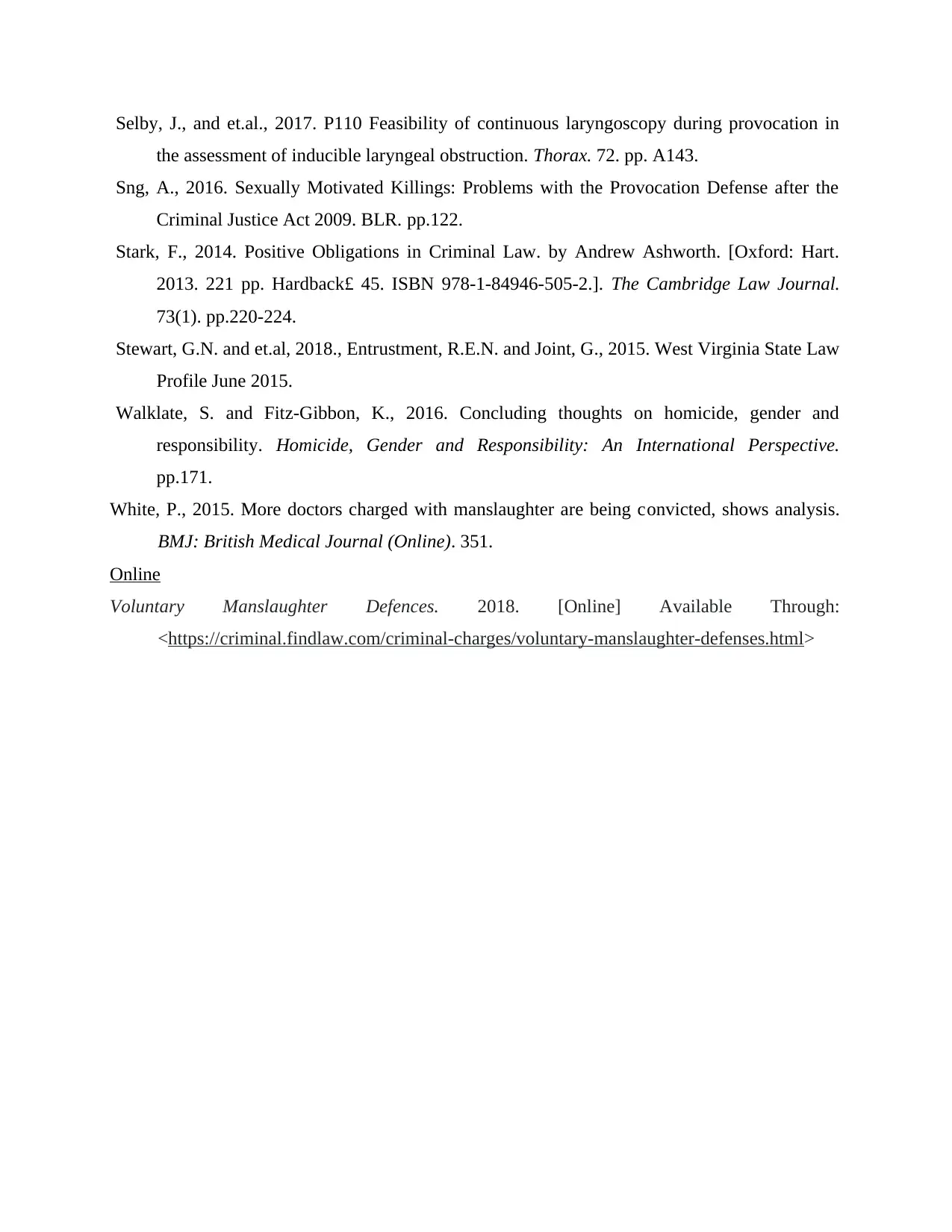
Selby, J., and et.al., 2017. P110 Feasibility of continuous laryngoscopy during provocation in
the assessment of inducible laryngeal obstruction. Thorax. 72. pp. A143.
Sng, A., 2016. Sexually Motivated Killings: Problems with the Provocation Defense after the
Criminal Justice Act 2009. BLR. pp.122.
Stark, F., 2014. Positive Obligations in Criminal Law. by Andrew Ashworth. [Oxford: Hart.
2013. 221 pp. Hardback£ 45. ISBN 978-1-84946-505-2.]. The Cambridge Law Journal.
73(1). pp.220-224.
Stewart, G.N. and et.al, 2018., Entrustment, R.E.N. and Joint, G., 2015. West Virginia State Law
Profile June 2015.
Walklate, S. and Fitz-Gibbon, K., 2016. Concluding thoughts on homicide, gender and
responsibility. Homicide, Gender and Responsibility: An International Perspective.
pp.171.
White, P., 2015. More doctors charged with manslaughter are being convicted, shows analysis.
BMJ: British Medical Journal (Online). 351.
Online
Voluntary Manslaughter Defences. 2018. [Online] Available Through:
<https://criminal.findlaw.com/criminal-charges/voluntary-manslaughter-defenses.html>
the assessment of inducible laryngeal obstruction. Thorax. 72. pp. A143.
Sng, A., 2016. Sexually Motivated Killings: Problems with the Provocation Defense after the
Criminal Justice Act 2009. BLR. pp.122.
Stark, F., 2014. Positive Obligations in Criminal Law. by Andrew Ashworth. [Oxford: Hart.
2013. 221 pp. Hardback£ 45. ISBN 978-1-84946-505-2.]. The Cambridge Law Journal.
73(1). pp.220-224.
Stewart, G.N. and et.al, 2018., Entrustment, R.E.N. and Joint, G., 2015. West Virginia State Law
Profile June 2015.
Walklate, S. and Fitz-Gibbon, K., 2016. Concluding thoughts on homicide, gender and
responsibility. Homicide, Gender and Responsibility: An International Perspective.
pp.171.
White, P., 2015. More doctors charged with manslaughter are being convicted, shows analysis.
BMJ: British Medical Journal (Online). 351.
Online
Voluntary Manslaughter Defences. 2018. [Online] Available Through:
<https://criminal.findlaw.com/criminal-charges/voluntary-manslaughter-defenses.html>
Paraphrase This Document
Need a fresh take? Get an instant paraphrase of this document with our AI Paraphraser

1 out of 11
Related Documents
Your All-in-One AI-Powered Toolkit for Academic Success.
+13062052269
info@desklib.com
Available 24*7 on WhatsApp / Email
![[object Object]](/_next/static/media/star-bottom.7253800d.svg)
Unlock your academic potential
Copyright © 2020–2025 A2Z Services. All Rights Reserved. Developed and managed by ZUCOL.





